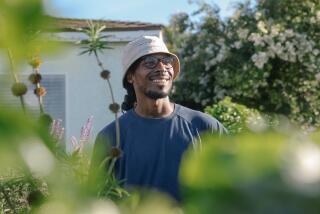The Banana Man: A Comeback Story
- Share via
Anyone who has taken the scenic drive along the 101 Freeway just north of Ventura couldn’t miss them: rows and rows of lush banana plants hung thick with fruit. It was as though a bit of South America had come seaside in Southern California.
Doug Richardson’s small banana plantation was the only substantial planting in California--and they weren’t just any bananas. He sold 50 exotic varieties at his roadside stand and farmers markets, from the green-and-white striped Ae Ae to the red-blotched Zebrina. Richardson was California’s banana guru, sought out by tourists, journalists and banana connoisseurs. But then came a mudslide in 1995, which wiped out the back of his farm. By 1999, Seaside Banana Gardens was just a memory.
If it was a quirk that the operation ever existed, another quirk has brought it back. Richardson is again selling his exotic bananas, but this time they’re being grown on a private estate owned by banana sympathizers in Carpinteria. His return is on a much smaller scale--fewer plants, and no roadside stand. But his followers are rejoicing as they discover Richardson is back in business.
Compared to bland, uniform supermarket bananas, Richardson’s varieties offer an astonishing range of forms and flavors. For example, an unripe Ice Cream banana has bizarre silvery blue-green skin. Ripe, the fruit turns pale yellow and has a lusciously creamy, snowy white pulp that tastes exceptionally sweet.
Such a banana is a rare treat in the United States: Bananas are native to Southeast Asia, and 99% of those eaten in this country (mostly the standard yellow Cavendish types) come from Central and South America.
Fate intervened a few years ago when Harry and Cricket Wilson asked Richardson for help landscaping the site for their new home. The Wilsons--he is a retired investment manager, and she is the former medical director at Pepperdine University--were having permit trouble because of high fire risk and danger of landslides.
Richardson was working in landscape design, but still nurturing a few plants that he’d salvaged after the mudslide and “dreaming of a new banana planting.” His solution to their steep, unstable terrain was--you guessed it--banana plants.
Richardson came up with a design combining fire protection, erosion control and specialty farming. For fire protection, he planted rings of exotic bananas--1,500 of them around the five-acre property. The plants are 85% water. They may look like trees, but botanically bananas are perennial herbs that grow new trunks every year and die back to their roots after they have fruited.
Banana plants have shallow roots, however, so to stabilize the soil, Richardson planted bands of vetiver, a fast-growing, clumping grass with roots that rapidly go down 10 feet. Richardson now oversees the bananas, and together with the Wilsons, sells them at local stores and by mail order.
While banana plants grow here and there in Southland backyards, Richardson has found the state’s banana belt. In this nearly frost-free area, sheltered by coastal mountains from northern winds, Richardson at one time grew some 100,000 banana plants on his 12-acre farm.
The Wilsons’ 1,500 banana plants started producing last summer. The harvest is year-round but peaks from August to October. Growing conditions at the new planting are more marginal than at the old location: The shallow soil is not ideal, and, on the exposed knoll, high winds rake the plants. Richardson uses wooden stakes to prop up many of the plants, which range from 6 to 20 feet tall.
“Some varieties, such as Cardaba and Ice Cream, naturally tend to lean,” he said. “All it takes is a heavy bunch and a 40-mph wind and the plant falls over.”
To protect the fruit against wind-scarring, Richardson’s workers tie blue plastic covers over the maturing stalks, with their “hands” of upward-curving “fingers.” When the fruits are almost ripe, with the top hand showing yellow or light green--a much more advanced stage than at commercial plantations--they chop down the stalk with a machete, cut off the bunches and store them in a shed to ripen further.
Richardson’s bananas are denser and thinner than imported commercial fruit. They develop more slowly, and they’re not as large. But the fruit sugars are more concentrated and they’re richer in flavor.
Having lunch at the Garden Market in Carpinteria recently, Richardson said his favorite variety is the Brazilian, also known as Hawaiian Apple, because of its smooth texture, fruity flavor and ideal balance of sweetness and acidity.
In the patio garden, where the lunch tables are bordered by rare banana plants for sale, his wife, Lisa, brought out a tasting plate of cooking bananas, sauteed in a little butter: Cardaba, Kaulau, Popoulu and Haa Haa. Starchier than dessert bananas, but less so than plantains, cooking bananas can be eaten fresh but develop more nuanced flavor when they’re heated.
Soon Richardson was heading off to his new job as chairman of the Environmental Horticulture Department at Santa Barbara City College, where he’ll teach others to farm on the unstable terrain so common in Southern California.
Before going, he stopped to savor a Mysore, a rich strawberry-citrus flavored banana from India with moist, tangy orange flesh.
“Taste one of these,” he said, “and you see why my banana project is so compelling.”
Doug and Lisa Richardson’s bananas are $2 a pound at the Garden Market, 3811 Santa Claus Lane, Carpinteria; (805) 745-5505. Open Monday to Friday, 7 a.m. to 5 p.m.; weekends, 8 a.m. to 5 p.m. The market also takes orders for 5 1/2 pounds of assorted bananas, delivered by second-day air: $45 in California, $50 elsewhere.






